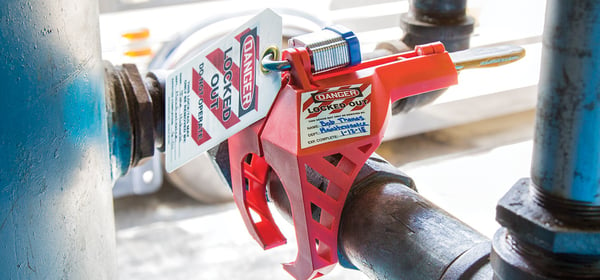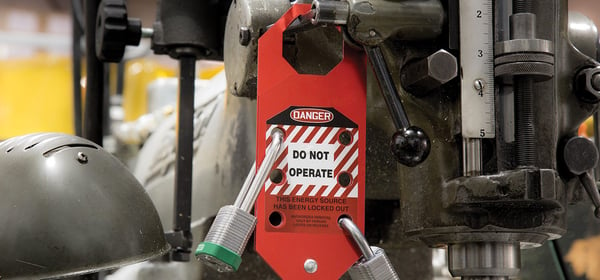
Understanding Lockout Tagout (1910.147 & 1910.333) and what it means for your company:
- What is Lockout Tagout (LOTO)? Lockout refers to the use of a device such as a lock to prevent a machine or equipment from being operated during service, repair or maintenance by isolating the energy. Tagout is a warning system, usually in the form of a tag attached to equipment, to let workers know that the machine cannot be operated until the tag is removed.
- Affected employee: Employee whose job responsibilities include operating, servicing or maintaining a machine or equipment that must be performed under lockout or tagout. This also includes employees who have job tasks that may be in areas that lockout or tagout is being performed.
- Authorized employee: The person who is responsible for lockout or tagout of machinery or equipment in order for servicing or maintenance to be performed. Affected employee can also be the authorized employee.
- Other Employees: Any employee who may be in the vicinity of necessary lockout or tagout
- APM’s: Alternative Protective Measures is a specific exception that relates to minor tool changes, adjustments and minor servicing that takes place during normal production operations. Effective alternative measures must be provided. Refer to ANSI Z244.1-2003 for more info
So what forms of energy are included in Lockout Tagout programs?
- Electrical
- Mechanical
- Pneumatic
- Chemical
- Thermal
- Hydraulic
- Other energy source
Here are some great products to make sure your facility is in compliance:
- Safety Series™ Xenoy® Body Padlock: Designed specifically for OSHA safety lockout compliance. Durable locks have a lightweight Xenoy lock body and come with permanent, write-on labels for instant on-site identification. Cylinder is key retaining to ensure padlock is not left unlocked.
- Laminated Lockout Tags: Heavy-duty laminated lockout tags comply with OSHA lockout/tagout standard. Durable polyester laminate resists water, grease and extreme temperatures. Withstands over 50 lbs. of pullout force. Customizable with name, department and expected completion. Accepts all safety padlocks.
- Aluminum Safety Padlocks, Keyed-Alike: Lightweight, corrosion-resistant aluminum padlocks feature anodized body with chrome-plated, boron alloy shackle with 1 1/2" clearance. Keyed alike, 5-pin cylinder.
- Bilingual Ladder Shield™ Kit OSHA Danger: Promote ladder safety by controlling unauthorized access.
- Adjustable Cable Lockout: Integrated safety hasp and cable is easy to use and ideal for both circuit breaker panel and side-by-side gate valve lockouts. Made of tough, multi-stranded 1/4" diameter steel cable and lightweight, dielectric Zenex™ thermoplastic body
Taking shortcuts in your LOTO program isn’t only going to get you knee deep in trouble with OSHA, you’re putting your own people at risk.
Having the right energy control systems in place saves about 250,000 incidents, 50,000 injuries and 120 fatalities every year! If you really want to talk numbers, almost 8,000 amputations happen every year in the workplace! If you want to take that risk, have at it — but the cost of locks, tags and training doesn’t even touch the cost of hospitalization, workers’ comp, and loss of productivity or legal fees.
Is your Standard Operating Procedure (SOP) for LOTO up to Par?
- Have a written energy control program in place
- Have annual assessments performed to identify energy hazards and what method of LOTO your facility needs
- Have written steps of your LOTO procedure (this should include no shortcuts or cutting of locks!)
- Identify the key Qualified Personnel responsible for LOTO?
- Train affected and authorized employees annually
- Test and retest to make sure your control program works
The key to effective LOTO programs is communication, training and actually using the right energy control system for the task.
Imagine this: Richard is responsible for maintenance and servicing of equipment in a plant. He gets called in to fix a machine and to do that, he has to insert part of his arms into the equipment. He turned off the power, but failed to follow LOTO procedures. He was in a hurry to go to lunch. Next thing you know, his buddy Frank came back from lunch and flipped the switch to start work. What do you think happened next?
What should Richard have done differently?
- Notify affected employees of intent to lock out equipment
- Review the written lockout procedure
- Perform the normal machine stop
- Shut off all energy isolation controls
- Lock out the energy isolation controls
- Dissipate any stored or residual energies
- Verify the zero-energy state to safely begin servicing
It’s not enough to just know this stuff. I expect Richard knew all of this, it’s a major part of his job description. You need to make sure it’s implemented. Unfortunately, Richard is now down an arm and doesn’t really hang out with Frank anymore. Frank is sad. Don’t be a Richard. Make sure your crew knows how and why Lockout Tagout is necessary and why it should become second nature. Are you 1000% positive you understand OSHA requirements for lockout tagout?
Safety: It's Your Life, It's Our Business









